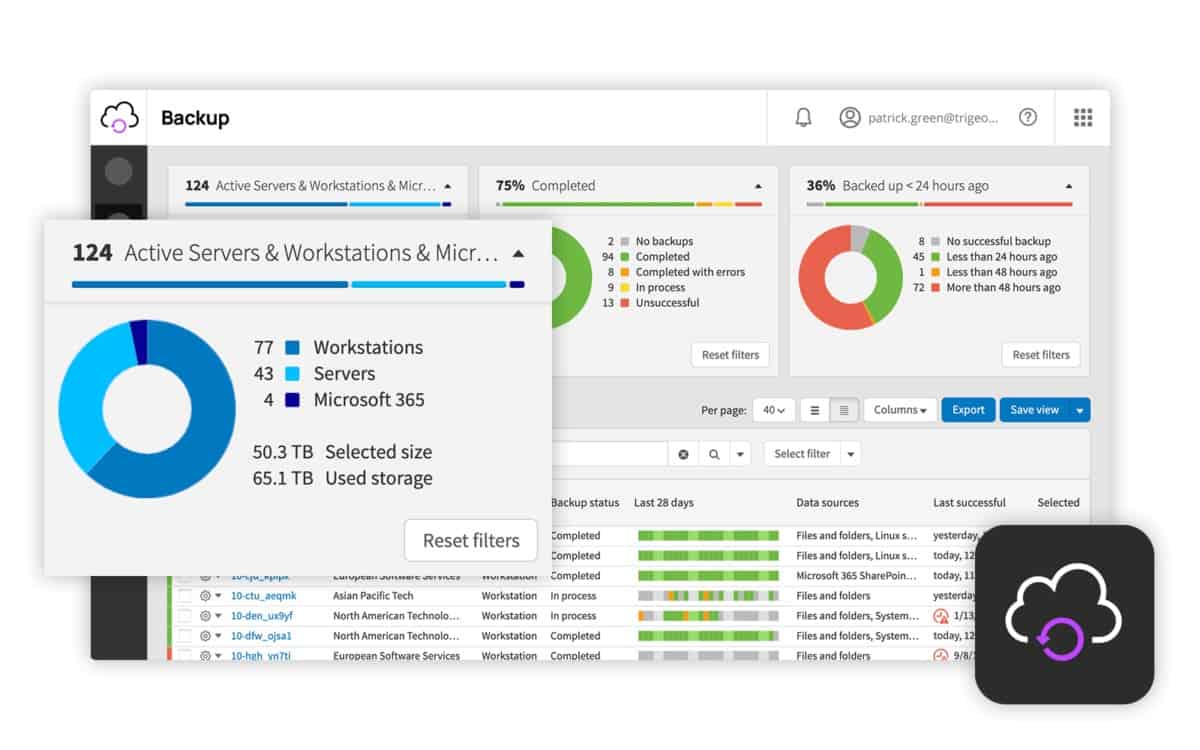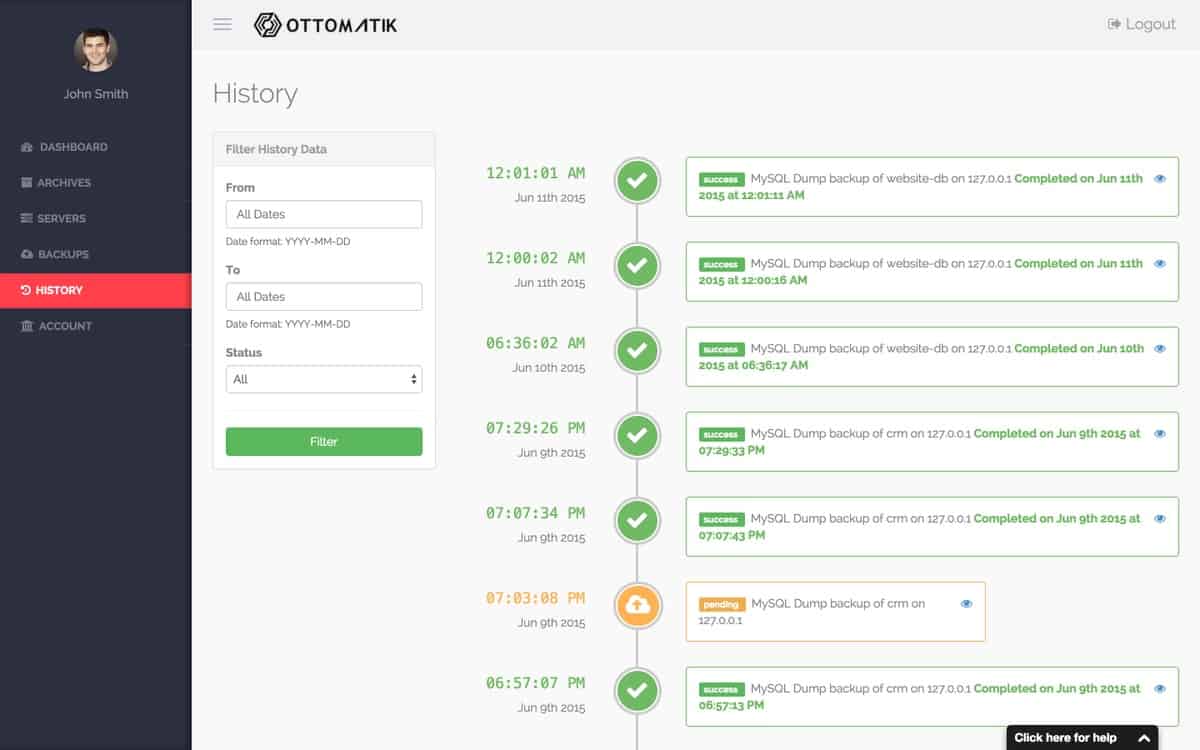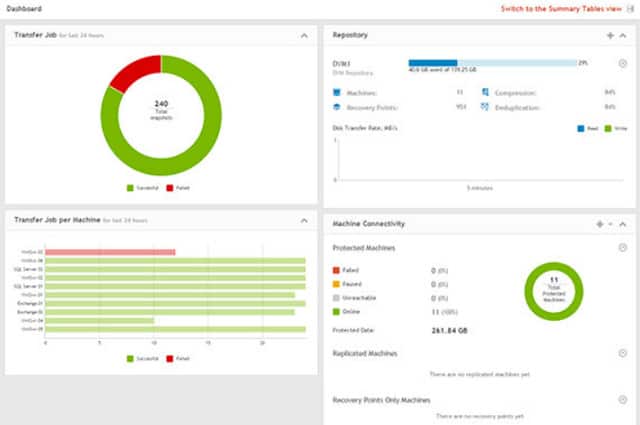Databases hold the vital information that drives your business. If this data is lost or damaged, the continuity of your business will be damaged. For example, it is impossible to create profit without records of orders, deliveries, invoices, and payments.
Threats to continuity include environmental disasters that damage or lose the database. Other problems can be caused by accidental damage or loss. Disgruntled employees or malicious outsiders with access can change or delete data. All of these issues will imperil your business.
A core system security strategy is to prepare for adversity. For example, preparations to protect against database damage are pretty straightforward – back up the database.
Here is our list of the five best database backup tools:
- N-able Backup EDITOR’S CHOICE This SaaS platform offers backup services for MySQL, SQL Server, and Oracle databases and includes secure, mirrored storage space.
- Ottomatik Protection for MySQL, MongoDB, and PostgreSQL databases delivered from a cloud platform.
- Iperius Backup This is an on-premises system that will protect Oracle, MySQL, SQL Server, SQL Express, PostgreSQL, and MariaDB databases. It runs on Windows and Windows Server.
- Quest Rapid Recovery This is an on-premises system that manages backup and recovery of SQL Server and Oracle databases. Available for Windows, Windows Server, and Linux.
- Acronis Cyber Backup A SaaS platform that offers subscriptions to backup servers and applications and can cover Oracle and SQL Server databases.
Database backup strategies
Backing up a database is as simple as taking a copy. However, you know that transactions are hitting your database all of the time, so copies frequently get out of date.
Backup strategies for databases rely on a play-off between completeness and performance.,So, naturally, copying every single transaction as it gets committed will slow down the response time of the database. However, leaving the backup refresh too long risks an event destroying a big chunk of business records.
The stance you take over the frequency of backup depends on the size of your business and the rate at which transactions occur. The traditional IT approach to backups involves backing up overnight when the office is closed, and there is no business activity and so no live perorations on the database. However, global businesses don’t have that luxury because there is always an office somewhere that is active. A business doesn’t need to be a large corporation to be globally active. Any website could be taking orders from anywhere in the world at any hour of the day or night.
How often should I backup my database?
Search on the Web for recommendations over backup frequencies, and you will see how quickly the world of IT evolves. You will see recommendations from 2015 and 2016 telling you to backup once a week (!!). A weekly backup strategy risks losing all data for the week. If you back up the database every Sunday, how much data would you lose if your server caught fire on a Friday?
A short-term solution can help you with a stop-gap, which is to write out transaction logs. These take less time to write out and, in most cases, just represent one more query on the database. Depending on the rate of change in your database, you can write our transaction logs every hour or every half hour.
With the cover of transaction logs, you can take a complete backup overnight. Then an incremental backup every 12 hours or every six hours. Finally, between backup actions, write out a transaction log every hour or half-hour.
As soon as a transaction log has been written, move it. You can write it to tape, to USB, or send it to a cloud directory. You will probably use both one local and one remote location. For example, if you write transaction logs every hour and perform a backup update every 12 hours, you will have 11 transaction log files. Once the update occurs, you can delete those files because the transactions they contain have been absorbed into the backup.
Transactions can be held in RAM (cache) for fast recovery. However, you need to be sure that the cache will endure a crash, and it won’t survive a physical disaster that destroys a server. Dumping that cache to a file periodically provides insurance.
Where should I hold my backups?
The location of backups is a factor that you can answer yourself through common sense. On the one hand, you need to be able to restore quickly, almost immediately if possible. On the other hand, you need to insure against environmental damage. A physical disaster on your site will lose you your backup as well as your original database.
The clear winner is to keep backups in two locations – locally for convenience and remotely for security. In addition to these two primary backups, you have your transaction logs. These should also be held in two locations – locally and remotely. Whether you keep both the primary backup and the transaction logs in the same place locally and remotely depends on the amount of confidence you have in your choice of backup storage provider.
If you don’t have confidence in the remote storage facility you use, you should probably look for another provider. Fortunately, most cloud platforms mirror contents over several data centers, so if your remote backup storage gets destroyed, it will be restored automatically.
The good idea is to adopt different strategies for backing up transaction logs to those used for the primary database backup. For example, you can write transaction logs to a directory with automatic syncing with a cloud server. Thus, your transaction logs will be saved and restored automatically.
How should I manage database backups?
Even very technically competent staff have plenty of tasks to occupy them and probably don’t want to spend too much time backing up the database. However, they would soon pay attention if a disaster occurred and data needed to be restored.
Recovery is only possible if backups are performed satisfactorily. Therefore, the tiresome task of backing up frequently cannot be overlooked. Fortunately, mundane, scheduled tasks are what software is very good at. Thus, the strategy that you need to adopt over database backups is to automate the process.
Database backup tools will take care of the data recovery process. Restoring data isn’t just a question of repopulating tables. The structure of the database changes over time, so continuity requires database objects to be stored and their contents.
The best database backup tools
Backing up a database isn’t as straightforward as copying over files. A database tool needs to get inside the database and extract all of its structures – its metadata – as well. That strategy can be implemented in many ways, so there are several different approaches that database backup tools employ.
What should you look for in a database backup tool?
We reviewed the market for systems to backup databases and analyzed the options based on the following criteria:
- A backup system that covers transaction logs as well as the database itself
- A service that can manage recovery from the cache
- The ability to manage backups locally and remotely
- A choice of tools that will run locally or as SaaS platforms
- Security for access control and also to protect stores from hackers or malware
- A free trial or a demo account for a no-obligation assessment
- Value for money represented by secure tools that will not fail offered at a reasonable price
We have identified some very reliable database backup and recovery systems that will quickly restore lost data with this set of criteria in mind.
You can read more about each of these options in the following sections.
1. N-able Backup
N-able Backup is a SaaS platform for backup, recovery, and replication. It supports MySQL, SQL Server, and Oracle databases. The package includes automated systems to manage backup and recovery and also cloud storage space. Both data transfers and storage is protected by AES-256 encryption, and the storage is mirrored on another data center to prevent loss in the cloud.
The N-able database backup system offers hot and warm backups, which can run while the database is still live and serving users. The backup gives you a complete copy of the database. So it can be used to replicate database instances in new locations or create copies for testing and development purposes. The system can also facilitate migration to a different platform, such as moving to the cloud.
Pros:
- Uses block-level deduplication to reduce transfer load
- Has a data compression routine to speed up data recovery
- It also offers backups for Microsoft 365, virtualizations, and complete servers.
- Facilitates migration and replication
- Available for cloud and on-premises database backups
Cons:
- No local backup options
Other options from N-able Backup include entire server backup for Windows Server and Linux, which would also cover your databases. Additionally, there is a multi-tenanted option available for managed service providers. N-able Backup service is available for a 30-day free trial.
EDITOR’S CHOICE
N-able Backup is our top pick for a database backup tool because it is very secure and incorporates automated storage mirroring. In addition, the N-able system doesn’t just manage the backups of databases because it will secure Microsoft 365, virtualizations, and entire servers.
Get a 30-day free trial: n-able.com/products/backup/trial
Operating system: Cloud-based
2. Ottomatik
Ottomatik is a SaaS system that includes a range of backup services, including database backups. The service provides coverage for MySQL, MongoDB, and PostgreSQL databases, and it provides an optional cloud storage service to support those functions.
The primary method used for database backups is the database dump. You extract structures and records into files and then transfer those files. There is also a regular file backup service, which would cover your transaction logs.
The user can attach an existing account with Dropbox, AWS, Backblaze, or Google Drive. Those who don’t already have an account with one of those platforms can take out an Ottomatik storage account on a separate subscription.
Pros:
- Backups that can be extracted while the database is serving users
- Options to backup transaction logs
- Scalable plans
Cons:
- No system for managing local backups
The Ottomatik service is available in four plans. That range makes the system attractive for businesses of all sizes. Subscriptions are available for monthly and annual payments with the yearly rate the equivalent of a 10-month charge. All plans are available for a 14-day free trial.
3. Iperius Backup
Iperius Backup covers SQL Server, MySQL, MariaDB, Oracle, and PostgreSQL databases. This package can also perform whole server backups and offers coverage for applications, such as virtualizations and Microsoft 365. This is an on-premises solution that requires the installation of the server module on at least one computer on your network.
Each computer that hosts a database will need an agent program installed on it. These agents provide local services coordinated by the server, where you set the variables of your backup strategy.
A system forensic data recovery service is included in the Iperius Backup plans. This is called Iperius Recovery Environment, which can scan damaged operating systems and reassemble broken file pointers. Iperius offers four plans, and only the top two of these, called Advanced and Full, include database backups.
The server of Iperius Backup installs on Windows Server. Its primary backup strategy is to transfer everything up to cloud storage. You can attach your cloud storage account or take out a subscription to the Iperius Cloud storage system. Backup files can be compressed to speed data transfers in both directions, and all transmissions are encrypted for security.
Pros:
- Backup service for SQL Server, MySQL, MariaDB, Oracle, and PostgreSQL
- Can recover files from damaged operating systems
- Caters to distributed configurations
Cons:
- The software needs to be hosted and maintained
There is a free version of Iperius Backup, but that doesn’t include database coverage. You can get a 21-day free trial of Iperius Backup.
4. Quest Rapid Recovery
Quest is a solid and reliable brand, and Rapid Recovery is an excellent choice to back up SQL Server and Oracle databases. The front end of Quest Rapid Recovery is called AppAssure, and the data extraction and transfer service are called ZeroIMPACT. Although these two elements have their brand names, they work together as an integrated package. The service will also backup transaction logs.
Quest Rapid Recovery can cover entire servers as well as applications. So, you could opt to backup your server, including the database. However, as this is an incremental service, it won’t copy over much of the other data on your server each time because it only takes copies of changes. Other applications that can be backed up individually with Rapid Recovery include Microsoft Exchange Server and SharePoint.
Both backup extraction and data restoration run while the database is live and serving users. The recovery will prioritize data that is being demanded by searches that users launch. The push of data replacement will prioritize those demands and operates quickly enough that users might say that response is a little slow rather than unacceptable.
Pros:
- Live backup and recovery processes
- Prioritized data recovery for user-demanded data
- It also backs up physical and virtual servers
Cons:
- Cloud storage space costs extra
Quest Rapid Recovery runs on Windows, Windows Server, and Linux. In addition, quest offers Rapid Recovery a 30-day free trial.
5. Acronis Cyber Backup
Acronis Cyber Backup is a cloud service that comes packaged with 250 GB of cloud storage space. This system offers a range of backup services, and its database backup system covers SQL Server and Oracle. Acronis can also backup virtualization and disks. However, you pay for each service separately.
One of the reasons you would want a backup system is to protect your system from ransomware attacks. The primary method of threat implemented by ransomware is to encrypt all of your files so that you can’t access them. The Acronis service includes a block on unauthorized encryption activity, so you don’t need to worry about ransomware.
The system is controlled by a console on the Acronis cloud server but requires agent programs to be installed locally on your site. The agents run as virtual appliances, which protect the system from hacker attacks. As well as performing database extracts, these local agents manage and secure the connection to the Acronis server where backups are sent. A VPN protects these transfers.
Acronis Cyber Backup can provide you with a local backup as well as a cloud copy. Thus, you get access to the local store for a speedy recovery and a cloud store for rock-solid protection. The cloud version can also be used for migration or replication.
Pros:
- Offers both local and cloud backup copies
- Includes cloud storage
- Performs ransomware protection routines
Cons:
- No on-site option
You can assess Acronis Cyber Backup with a 30-day free trial.
L’article 5 Best Database Backup Tools est apparu en premier sur Comparitech.






0 Commentaires